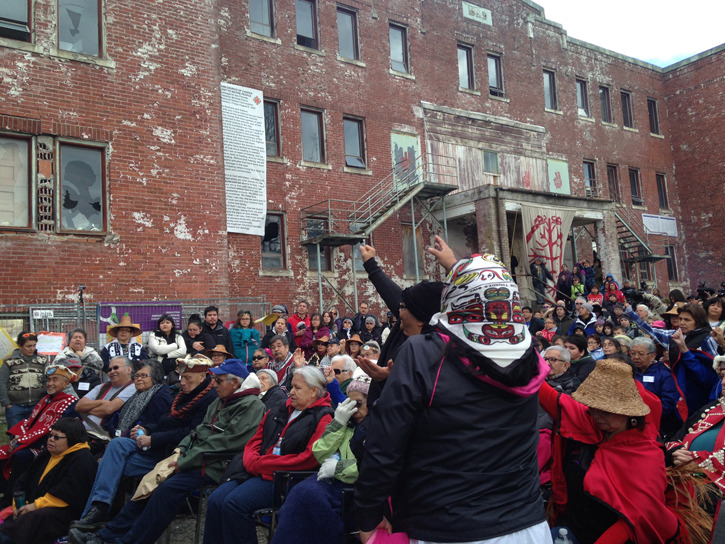Nuxalkmc Survivors, Family Members Attend St. Michaels Residential School Demolition
By Caitlin Thompson
Hundreds of people gathered in the small community of Alert Bay last week to witness a symbolic end to a dark period of Canadian history: the destruction of St. Michael’s Residential School. Although its doors officially closed in 1974, the impact of the school is still very much alive. The first church-run residential school in the area dates back to 1882, and St. Michael’s opened its doors in 1929 in Alert Bay on Cormorant Island, near Port McNeill on northern Vancouver Island. Constructed by the B.C. government, it was the largest school of its kind operated by the Anglican Church. St. Michael’s school held aboriginal people from northern Vancouver Island and B.C.’s north coast, including from Bella Bella, Bella Coola, the Nisga’a territories and Haida Gwaii. An estimated 160,000 children attended residential schools across Canada and last Wednesday, a massive survivor ceremony hosted by the Namgis First Nation celebrated the demolition of St. Michael’s. Spearheaded by Rhonda Sandoval and Faye Edgar and funded by Nuxalk Health and Wellness, more than a dozen Nuxalkmc made the journey to Alert Bay, some as survivors and some as descendants and family members. Survivor Leonard Pootlass was among them. “I feel a sense of relief in my whole being,” said Pootlass. “To watch that building come down was exhilarating. I threw a stone at it and lay flowers there for my two brothers who are no longer here.” Pootlass, who will turn 69 this year, was taken from this community at the age of five. Having grown up with his grandfather, he only spoke Nuxalk. He first arrived in Port Alberni, where was beaten daily for speaking his language. In 1958 he was sent to St. Michael’s and spent two years there. Five of his siblings also attended: three sisters and two brothers. Both of his brothers passed away in violent deaths. Pootlass acknowledges the experience left him angry and bitter, and credits his wife for putting up with him for almost four decades. “I know I wasn’t the easiest person to live with,” he admits. “I’d really like to thank my wife for being such a strong person; she’s my biggest supporter.” Pootlass said he was anxious and scared to revisit St. Michael’s, having been there only once in the 56 years since he left. The transformation is obvious. “The biggest battle was in my mind, just to go there,” he said. “Now that that’s over, I feel like that athlete that’s crossed the final hurdle.” Dark memories have haunted him ever since he left. In particular, he would often hear the sound of a young boy, fresh to the school, who cried for his family for hours upon his arrival. Now he’s free. “I have overcome it. I feel like the world’s been lifted off my shoulders,” he said. “The past is still alive, that’s for certain, but I am not going to dwell on it anymore. I’ve forgiven those people. It’s not going to depress me anymore. I’m really thankful to those who gave us the opportunity to go.” Cultural leader and elder Karen Anderson and her niece, Vanessa Hans Moody, a cultural teacher at Acwsalcta School, also traveled to Alert Bay to witness the ceremony. Even though both women didn’t attend residential school, Anderson acknowledged that the intergenerational trauma continues to directly affect the survivor’s families, reaching deep into generations born much later. Moody’s mother attended St. Michaels, and so did the majority of Anderson’s 13 siblings. “Eight of my thirteen siblings attended residential school,” said Anderson. “Many of them went to Alert Bay. The reason I can still speak my language is because I stayed home with my mom, and she only spoke Nuxalk to me.” Anderson says she remembers village elders warning the mothers, calling out in Nuxalk that the government agents were coming to take the children away. “My sister Penny still cannot stand the smell of musty potatoes,” she shared, “because my mom hid her in the potato bin when they came looking for her.” Anderson said her brother, who was hastily hidden under the stairs, saw a rat and cried out. The government agents found him and took him away. “I remember my mom crying and crying,” she said. “I can’t imagine her pain.” Moody said many of the ceremonies at Alert Bay were intended to celebrate the opposite of what occurred at the school. Former students were encouraged to fill their plates, to take more than they needed or could eat to “take back their starving times.” “The atmosphere was so powerful, it was like being in a movie,” said Moody. “When they smashed that building down people were crying and wailing, it was intense.” Both women felt that the closure offered by the demolition is another step on the healing journey for the survivors, and also a reminder of how far they have come as Nuxalkmc people. “That’s what our Acwsalcta School is about,” Anderson explains. “We’re recovering our language, our links to the past, our rights to be Nuxalkmc people. These stories of survival shouldn’t be forgotten, but they don’t have to define who we are.”
|
.
Any original material on these pages is copyright © BishopAccountability.org 2004. Reproduce freely with attribution.
